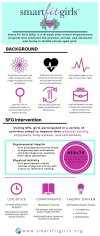The Influence of a Girls' Health and Well-Being Program on Body Image, Self-Esteem, and Physical Activity Enjoyment
- PMID: 37754061
- PMCID: PMC10525767
- DOI: 10.3390/bs13090783
The Influence of a Girls' Health and Well-Being Program on Body Image, Self-Esteem, and Physical Activity Enjoyment
Abstract
Adolescent girls report low physical activity levels and poor body image and self-esteem. This study evaluated the impact of a girls' health intervention on body image, self-esteem, and physical activity enjoyment. The intervention was grounded in self-determination theory, resulting in lessons designed to promote autonomy, competence, and relatedness. The two primary components of the intervention included opportunities for girls to learn about resistance training as well as ways to improve their psychosocial health (i.e., body image, self-esteem, and physical activity enjoyment). Girls (n = 590), in the intervention (Mage = 12.79, SD = 0.69) and control group (Mage = 12.92, SD = 0.73), completed pre and post measures. A repeated measures MANOVA was conducted to assess changes in body image, self-esteem, and physical activity enjoyment. The intervention resulted in a significant increase in body esteem-appearance, F = 9.23, p = 0.003, and body esteem-weight, F = 4.77, p = 0.029, and a greater, non-significant, increase in self-esteem (3.22%), and physical activity enjoyment (4.01%) compared to the control group. This highlighted the use of the intervention for significant improvements in appearance and weight-related body image. The results support implementing psychosocial lessons, as well as physical activity, in health programming for girls.
Keywords: adolescence; female; physical activity; psychosocial health; resistance training.
Conflict of interest statement
Two of the authors serve on the SFG Board of Directors.
Figures
References
-
- U.S. Department of Health and Human Services Physical Activity Guidelines for Americans, 2nd ed. [(accessed on 24 September 2021)]; Available online: https://health.gov/healthypeople/tools-action/browse-evidence-based-reso....
-
- Dale L.P., Vanderloo L., Moore S., Faulkner G. Physical activity and depression, anxiety, and self-esteem in children and youth: An umbrella systematic review. Ment. Health Phys. Act. 2019;16:66–79. doi: 10.1016/j.mhpa.2018.12.001. - DOI
-
- Cooper A.R., Goodman A., Page A.S., Sherar L.B., Esliger D.W., van Sluijs E.M., Andersen L.B., Anderssen S., Cardon G., Davey R. Objectively measured physical activity and sedentary time in youth: The International children’s accelerometry database (ICAD) Int. J. Behav. Nutr. Phys. Act. 2015;12:1–10. doi: 10.1186/s12966-015-0274-5. - DOI - PMC - PubMed
LinkOut - more resources
Full Text Sources


